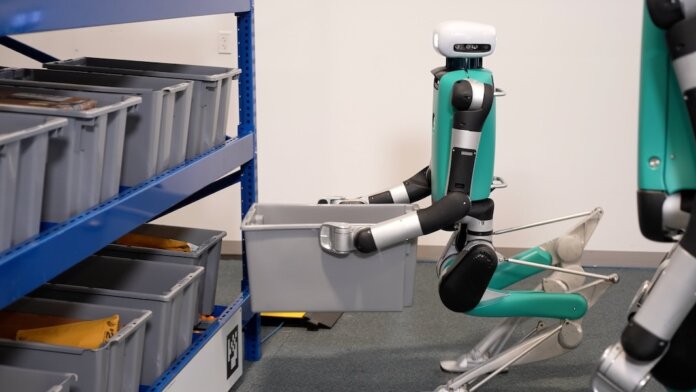Simple robots have long been a manufacturing staple, but more advanced robots—think Boston Dynamics’ Atlas—have mostly been bespoke creations in the lab. That’s begun to change in recent years as four-legged robots like Boston Dynamics’ Spot have gone commercial. Now, it seems, humanoid robots are aiming for mass markets too.
Agility Robotics announced this week it has completed a factory to produce its humanoid Digit robot. The 70,000-square-foot facility, based in Salem, Oregon has a top capacity of 10,000 robots annually. Agility broke ground on the factory last year and plans to begin operations later this year. The first robots will be delivered in 2024 to early customers taking part in the company’s partner program. After that, Agility will open orders to everyone in 2025.
“The opening of our factory marks a pivotal moment in the history of robotics: the beginning of the mass production of commercial humanoid robots,” Damion Shelton, Agility Robotics’ cofounder and CEO said in a press release Tuesday.
The latest version of Digit stands 5 feet 9 inches tall and weighs 141 pounds, according to the company’s website. It has a flat head with a pair of emoji-like eyes, two arms designed to pick up and move totes and boxes, and walks on legs that hinge backwards like a bird’s. The robot can work 16 hours a day and docks itself to a charging station to refuel.
Founded in 2015, Agility Robotics was spun out of Oregon State University’s Robotics Laboratory, where robotics professor and cofounder Jonathan Hurst leads research in legged robots. Little more than a pair of legs, Digit’s direct ancestor Cassie launched in 2017. Agility had added arms and a suite of sensors, including a vaguely head-like lidar unit, by the time it announced the first commercial version of Digit in early 2020.
Back then, Digit was marketed as a delivery robot that would unfold from the back of a van and drop packages on porches. Though its first broad commercial application will instead be moving boxes and totes, the company still views Digit as a multi-purpose platform with other uses ahead.
“I believe dynamic-legged robots will one day help take care of elderly and infirm people in their homes, assist with lifesaving efforts in fires and earthquakes, and deliver packages to our front doors,” Hurst wrote for IEEE Spectrum in 2020.
To go bigger, however, the company will have to prove Digit is widely useful beyond the experimental and then figure out how to make it en masse.
That’s where the new factory, dubbed RoboFab, comes in. To date, robots like Digit are made in the single digits or dozens at most. Atlas is still a research robot—though its slick moves make for viral videos—and a new push into humanoid robots by other players, including the likes of Tesla, Figure, and Sanctuary, is only just getting started.
It would be an impressive achievement if Agility hews to its aggressive timeline.
Apart from building and opening a factory, challenges to scaling include setting up a steady supply chain, nailing consistent product quality beyond a few units, and servicing and supporting customer robots in the field. All that will take time—maybe years. And of course, in order to produce 10,000 robots annually, they have to sell that many too. The company expects the first year’s production to be in the hundreds.
But if Digit proves capable, affordable, and easy for businesses to integrate in the years ahead, it seems likely there would be ample demand for its box-and-tote picking skills. Amazon invested in Agility’s $150-million Series B in 2022 and has been packing its warehouses with robots for years. Digit could fit an unfilled niche in its machine empire.
Further broadening the number of tasks the robot can complete—and thereby widening the market—would likewise boost demand for the bot. Amazon, and others no doubt, would likely be more than willing to entertain the idea of Digit one day delivering packages.
But first, Agility will have to fire up the assembly line and prove they can keep it humming along at a healthy pace.
Image Credit: Agility Robotics




